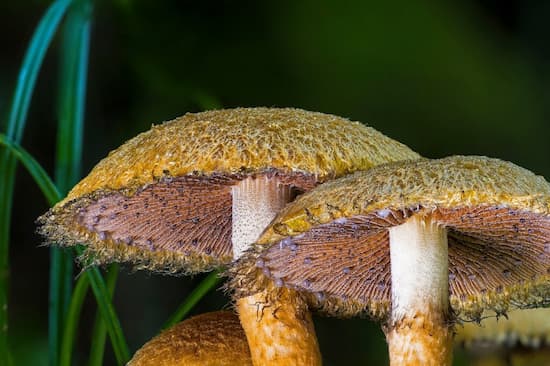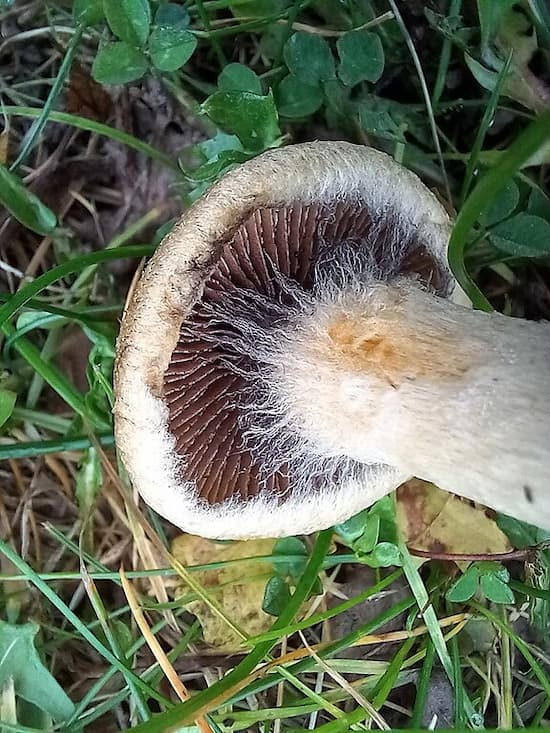The Weeping Widow mushroom (Lacrymaria velutina or Lacrymaria lacrymabunda) is a distinctive fungus characterized by its velvety, dark brown to tan cap and gills that exude droplets of moisture, resembling tears.
In this article, you are going to learn how to identify it in the wild and many other relevant information.
How To Identify Weeping Widow Mushroom?
Here is how you can identify Weeping Widow in the wild::
First, examine the cap
The cap ranges from 2 to 7 centimeters in diameter. Initially, it appears conical or bell-shaped, but it flattens as the mushroom ages. The surface of the cap is brown and often darkens when wet, presenting a shaggy or fibrous texture. Additionally, younger specimens frequently exude moisture droplets on the cap, giving the mushroom its characteristic “weeping” appearance.

Next, look at the gills underneath the cap. They are dark, almost black, and densely packed. While they start off pale brown, they darken as the mushroom matures. The gills might secrete a dark fluid, further contributing to the weeping effect that defines this mushroom.
Then, observe the stem, or stipe
The stem is slender and measures between 3 and 10 centimeters in height and 0.2 to 0.6 centimeters in thickness. The stem varies in color from whitish to brownish and often has a fibrous texture. The base of the stem typically thickens and may have a slightly bulbous appearance, distinguishing it from other similar mushrooms.
Spore Print
For a more definitive identification, perform a spore print. Place the cap, gills down, on a white piece of paper and cover it with a bowl, leaving it overnight. The spore print should be black, which is a key identifying feature of the Weeping Widow.
Habitat
Additionally, consider the mushroom’s habitat. The Weeping Widow often grows in grassy areas, gardens, parks, and woodlands, thriving in nutrient-rich soils like compost and leaf litter. This mushroom typically appears from spring to autumn, aligning with the growing season of many other mushrooms.
By carefully observing these characteristics and understanding the typical environments where the Weeping Widow grows, you can accurately identify this mushroom in the wild. However, always exercise caution and consult an expert when foraging, as many mushrooms can look similar and some are toxic.
Weeping Widow Etymology
The name “Weeping Widow” for the mushroom Lacrymaria lacrymabunda derives from its distinctive physical characteristics.
The genus name “Lacrymaria” comes from the Latin word “lacrima,” meaning “tear,” due to the way this mushroom’s cap often exudes droplets of moisture, resembling tears.
Additionally, the species name “lacrymabunda” translates to “abundant tears,” reinforcing this tear-like quality. This tear-shedding appearance likely inspired the evocative common name “Weeping Widow.”
Is Weeping Widow Edible Mushroom?
No, the Weeping Widow (Lacrymaria lacrymabunda) is not an edible mushroom. Although it might not be highly toxic, consuming it is still unsafe.
Some individuals report experiencing gastrointestinal issues after ingesting it. Furthermore, the mushroom’s resemblance to other toxic species adds to the risk of misidentification, which could lead to severe poisoning.
Therefore, foraging enthusiasts should avoid this mushroom to prevent potential health hazards.
- Texture: The mushroom has a tough and fibrous texture, making it unpleasant to eat.
- Palatability: It lacks significant flavour, which further reduces its appeal as a food source.
- Culinary Value: Due to its texture and lack of flavour, it has no notable culinary value and is not sought after by foragers.
Is Weeping Widow Mushroom Psychedelic?
The Weeping Widow mushroom (Lacrymaria lacrymabunda) is not psychedelic. It does not contain the psychoactive compounds typically found in psychedelic mushrooms, such as psilocybin or psilocin.
Therefore, consuming the Weeping Widow will not produce any hallucinogenic effects. Instead, it is best to avoid this mushroom due to its potential for causing gastrointestinal discomfort and its similarity to toxic species.

Side Effects of Weeping Widow?
While it is not widely known to be toxic, there is limited information about its potential side effects. Here are some considerations regarding the possible side effects of consuming this mushroom:
- Gastrointestinal Distress: As with many inedible mushrooms, consuming the Weeping Widow could cause stomach discomfort, nausea, vomiting, or diarrhoea. This is a common reaction to ingesting mushrooms that are not meant for human consumption.
- Allergic Reactions: Some individuals may experience allergic reactions to certain mushroom species, which could manifest as skin rashes, respiratory issues, or other allergic symptoms.
- Unknown Toxicity: While there are no well-documented cases of poisoning from the Weeping Widow, the lack of comprehensive studies means that potential toxic effects cannot be entirely ruled out.
Weeping Widow Mushroom Dogs
The Weeping Widow mushroom is potentially harmful if ingested by dogs.
While specific toxic effects on dogs are not well-documented, it is prudent to prevent pets from consuming any wild mushrooms due to the risk of poisoning. Here are some potential concerns and steps to take if you suspect your dog has ingested a Weeping Widow mushroom or any unknown mushroom:
Potential Risks
- Gastrointestinal Issues: Ingesting inedible mushrooms can cause vomiting, diarrhea, and other gastrointestinal distress in dogs.
- Toxic Reactions: Although the Weeping Widow is not known to be highly toxic, the specific effects on dogs are not well studied, and some mushrooms can cause severe reactions.
- Allergic Reactions: Dogs may experience allergic reactions, which can range from mild to severe.
Symptoms to Watch For
- Vomiting
- Diarrhea
- Drooling
- Lethargy
- Loss of appetite
- Abdominal pain
- Tremors or seizures (in severe cases)
What to Do
- Remove Access: If you see your dog eating a mushroom, remove them from the area immediately.
- Identify the Mushroom: If possible, take a sample of the mushroom for identification by a mycologist or veterinarian.
- Monitor Symptoms: Keep a close eye on your dog for any signs of illness.
- Contact a Veterinarian: If you suspect your dog has ingested a potentially harmful mushroom, contact your veterinarian or an emergency animal poison control center right away. Provide them with as much information as possible about the mushroom and your dog’s symptoms.
Prevention
- Supervise Outdoors: Keep a close watch on your dog while they are outside, especially in areas where mushrooms are known to grow.
- Regular Yard Checks: Regularly inspect your yard and remove any mushrooms that appear.
By taking these precautions, you can help ensure your dog’s safety and prevent potential mushroom poisoning.


